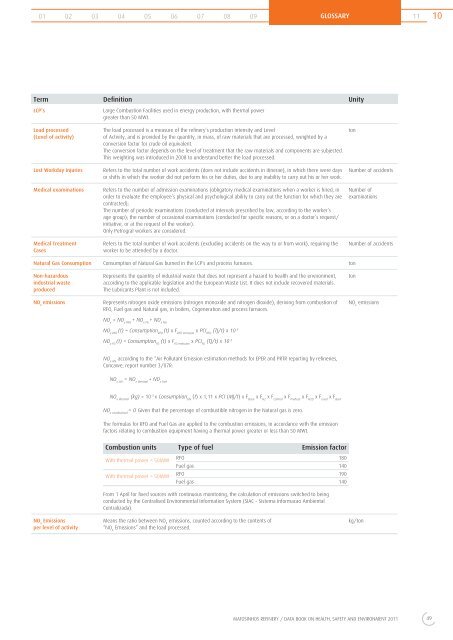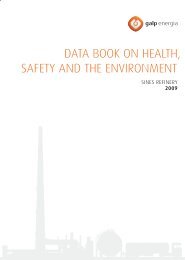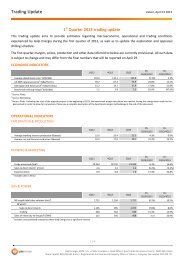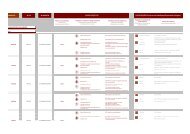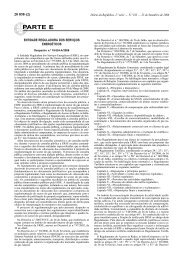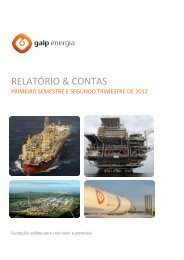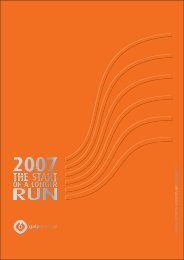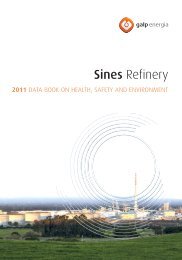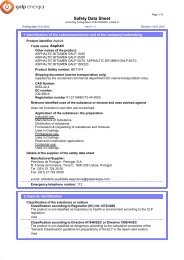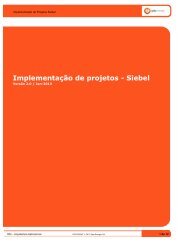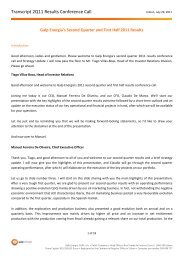2011 Matosinhos Data Book - Galp Energia
2011 Matosinhos Data Book - Galp Energia
2011 Matosinhos Data Book - Galp Energia
You also want an ePaper? Increase the reach of your titles
YUMPU automatically turns print PDFs into web optimized ePapers that Google loves.
01<br />
02<br />
03<br />
04<br />
05<br />
06<br />
07<br />
GLOSSARY<br />
08 09 11<br />
Term Defi nition Unity<br />
LCP’s Large Combustion Facilities used in energy production, with thermal power<br />
greater than 50 MWt.<br />
Load processed<br />
(Level of activity)<br />
The load processed is a measure of the refi nery’s production intensity and Level<br />
of Activity, and is provided by the quantity, in mass, of raw materials that are processed, weighted by a<br />
conversion factor for crude oil equivalent.<br />
The conversion factor depends on the level of treatment that the raw materials and components are subjected.<br />
This weighting was introduced in 2008 to understand better the load processed.<br />
Lost Workday injuries Refers to the total number of work accidents (does not include accidents in itinerae), in which there were days<br />
or shifts in which the worker did not perform his or her duties, due to any inability to carry out his or her work.<br />
Medical examinations Refers to the number of admission examinations (obligatory medical examinations when a worker is hired, in<br />
order to evaluate the employee’s physical and psychological ability to carry out the function for which they are<br />
contracted);<br />
The number of periodic examinations (conducted at intervals prescribed by law, according to the worker’s<br />
age group); the number of occasional examinations (conducted for specifi c reasons, or on a doctor’s request/<br />
initiative, or at the request of the worker).<br />
Only Petrogral workers are considered.<br />
Medical Treatment<br />
Cases<br />
Refers to the total number of work accidents (excluding accidents on the way to or from work), requiring the<br />
worker to be attended by a doctor.<br />
Natural Gas Consumption Consumption of Natural Gas burned in the LCP´s and process furnaces. ton<br />
Non-hazardous<br />
industrial waste<br />
produced<br />
Represents the quantity of industrial waste that does not represent a hazard to health and the environment,<br />
according to the applicable legislation and the European Waste List. It does not include recovered materials.<br />
The Lubricants Plant is not included.<br />
NO emissions Represents nitrogen oxide emissions (nitrogen monoxide and nitrogen dioxide), deriving from combustion of<br />
x<br />
RFO, Fuel gas and Natural gas, in boilers, Cogeneration and process furnaces.<br />
NO = NO + NO + NO x x RFO x FG x NG<br />
NO (t) = Consumption (t) x F x PCI (TJ/t) x 10 x RFO RFO RFO emission RFO -3<br />
NO x Emissions<br />
per level of activity<br />
NO x FG (t) = Consumption FG (t) x F FG emission x PCI FG (TJ/t) x 10 -3<br />
NO x GN according to the “Air Pollutant Emission estimation methods for EPER and PRTR reporting by refi neries,<br />
Concawe, report number 3/07R:<br />
NO x GN = NO x thermal + NO x fuel<br />
NO x thermal (kg) = 10 -3 x Consumption GN (t) x 1,11 x PCI (MJ/t) x F Base x F H2 x F Control x F Preheat x F H2O x F Load x F Burn<br />
NO x combustível = O Given that the percentage of combustible nitrogen in the Natural gas is zero.<br />
The formulas for RFO and Fuel Gas are applied to the combustion emissions, in accordance with the emission<br />
factors relating to combustion equipment having a thermal power greater or less than 50 MWt.<br />
Combustion units Type of fuel Emission factor<br />
With thermal power < 50MWt<br />
RFO 180<br />
Fuel gas 140<br />
With thermal power > 50MWt<br />
RFO 190<br />
Fuel gas 140<br />
From 1 April for fi xed sources with continuous monitoring, the calculation of emissions switched to being<br />
conducted by the Centralised Environmental Information System (SIAC - Sistema Informacao Ambiental<br />
Centralizada).<br />
Means the ratio between NO X emissions, counted according to the contents of<br />
“NO X Emissions” and the load processed.<br />
MATOSINHOS REFINERY / DATA BOOK ON HEALTH, SAFETY AND ENVIRONMENT <strong>2011</strong><br />
ton<br />
Number of accidents<br />
Number of<br />
examinations<br />
Number of accidents<br />
ton<br />
NO x emissions<br />
kg/ton<br />
49<br />
10


